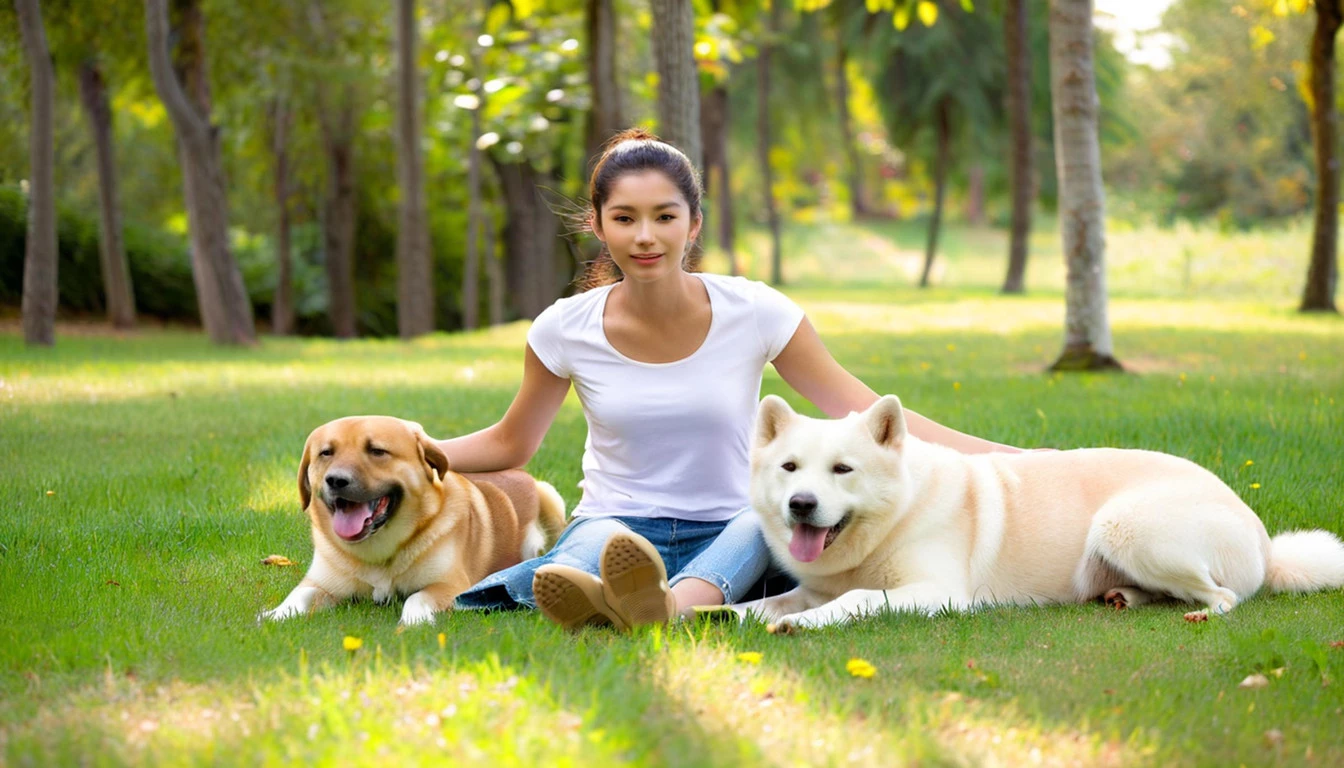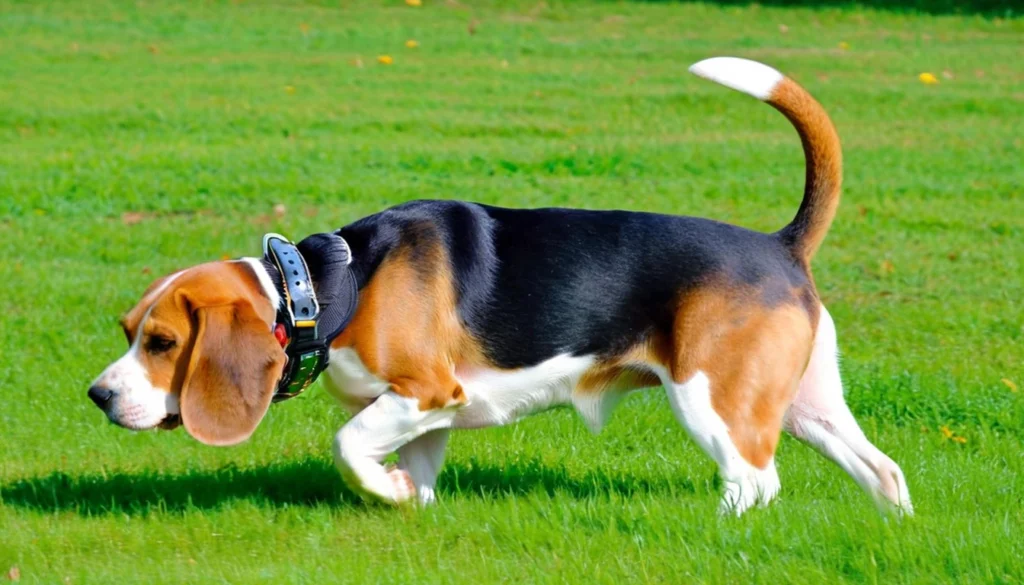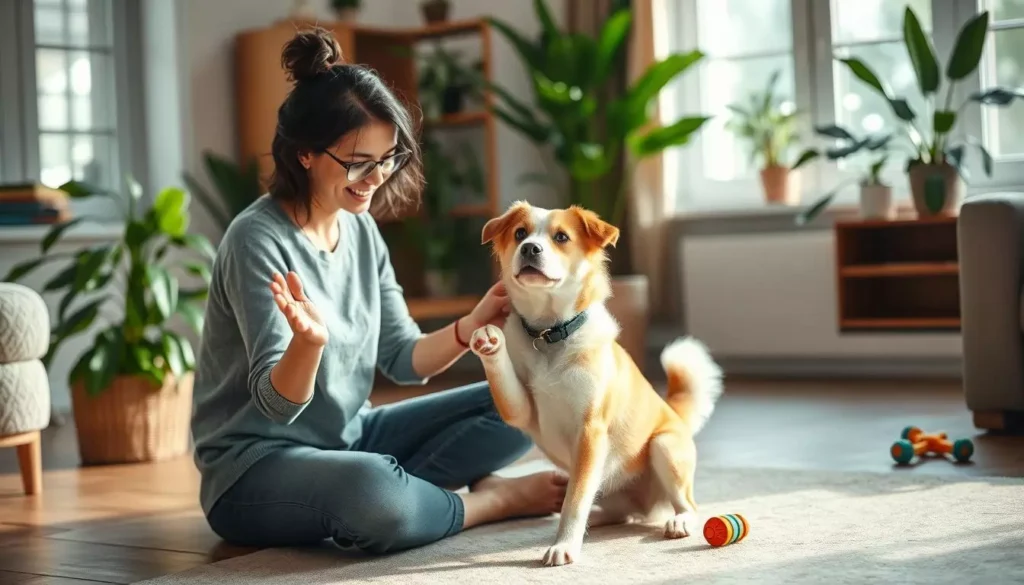Seeing my dog hesitate in fun situations breaks my heart. It's clear they lack confidence in new places or with new friends. Learning how to build confidence in dogs is crucial for their happiness and our bond.
By using effective dog confidence building tips, I can help my dog feel safe and sure of themselves. This way, they can enjoy the world around them without fear.
Key Takeaways
- Understanding dog behavior is essential for boosting confidence.
- Socialization plays a crucial role in a puppy's development.
- Identifying signs of low confidence in dogs can lead to effective solutions.
- Engagement through play is a great way to build confidence.
- Establishing a trusting relationship will aid in your dog's confidence-building journey.
- Creating positive experiences helps alleviate fear responses.
Understanding Dog Behavior and Confidence
To help my dog feel more confident, I need to understand their behavior. Dogs may show fear or insecurity in different ways, like barking a lot, lunging, or hiding. It's important to know what these behaviors mean to help them feel better.
Reading my dog's body language is key. I've found that fear can come from bad experiences, not enough socialization, or genetics. By paying attention to their needs, I can spot what makes them stressed and find ways to calm them down.
Learning about dog behavior helps me build trust with them. With the right information, I can make a space where they feel confident and happy. It's about knowing their personality and meeting their needs in the right way.
The Importance of Socialization for Puppies
Socialization is key for puppies to grow into well-adjusted dogs. Between 3 and 14 weeks, puppies need to experience many things. This helps them learn to handle different places, sounds, and people.
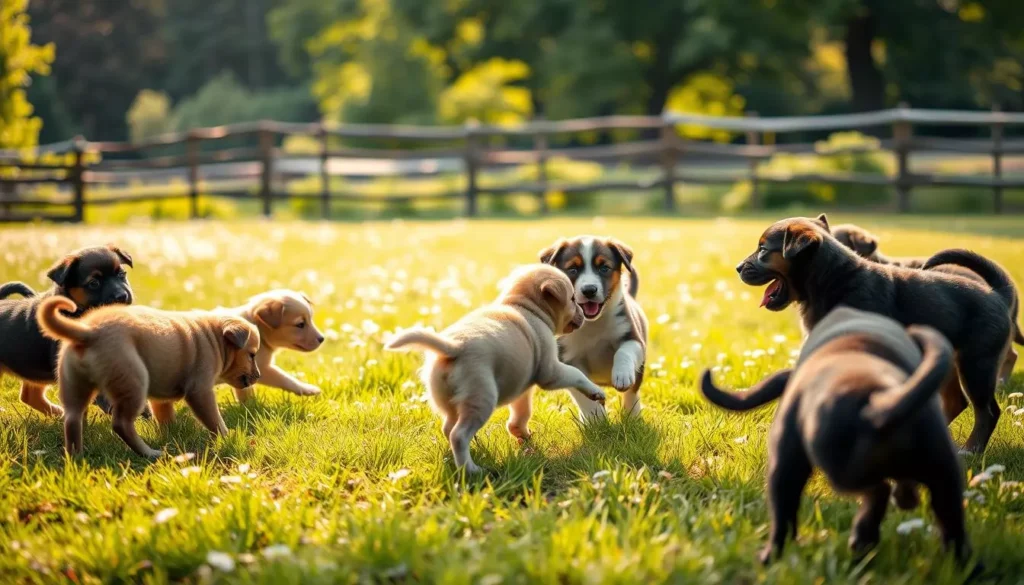
Positive interactions help build my puppy's confidence. Regular, short experiences with new things help my puppy feel comfortable, not scared. Without enough socialization, puppies might become anxious or fearful later.
I make sure my puppy's social activities are fun and stress-free. By introducing them to new sights and sounds slowly, I help them become confident dogs. They learn to face the world without fear.
Signs Your Dog May Lack Confidence
It's important to know if my dog lacks confidence. I look for signs of dog anxiety like backing away or staying close to me. A low body posture is also a sign.
Dogs may hide or avoid new things when they're anxious. This shows they're not feeling secure. I need to notice these signs to help my dog feel better.
Excessive barking or growling can mean my dog is scared. Seeing them cower is very upsetting. By paying attention to these signs, I can help my dog feel more confident.
How to Build Confidence in Dogs
Building confidence in dogs takes patience and careful planning. One good way is to use desensitization. This means slowly introducing my dog to things that scare them. I start from far away and let them get closer at their own speed.
This helps my dog feel safe while they get used to scary things.
Repeated Exposure to Fearful Stimuli
By facing their fears over and over, my dog learns they are safe. It's important to keep things calm to avoid scaring them more. For example, if they're scared of loud noises, I start with soft sounds.
Then, I slowly make the sounds louder. I watch my dog closely to make sure they stay calm and interested.
Counter-Conditioning Techniques for Dogs
Counter-conditioning works well with desensitization. It involves making scary things positive by adding treats or praise. If my dog is scared of thunder, I give them treats during a storm.
This makes them think of thunderstorms as good times. Doing this often helps my dog feel more confident around scary things.
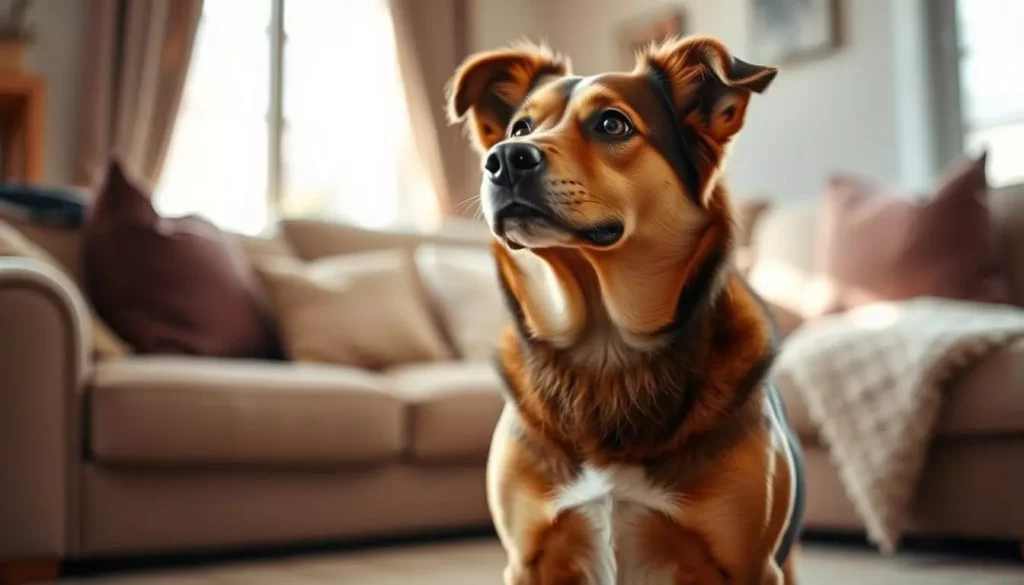
| Technique | Description | Purpose |
|---|---|---|
| Desensitization | Gradually exposing a dog to fearful stimuli from a safe distance. | To reduce the dog's anxiety over time. |
| Counter-Conditioning | Pairing fear-inducing experiences with positive reinforcements like treats. | To change the dog's emotional response to a fearful situation. |
General Confidence Building Activities
Building my dog's confidence is a mix of fun activities that keep their mind sharp and strengthen our bond. By trying different confidence building exercises, my dog feels safer and more open. This part talks about the value of play, enrichment, and training in building trust and understanding.
Engagement Through Play and Enrichment
Play and enrichment activities are great for boosting my dog's confidence. Activities like interactive toys and puzzle feeders keep their mind busy and make them feel accomplished. I use food puzzles and nose work games to challenge them and tap into their natural skills.
These fun activities not only entertain but also help my dog feel more confident as they solve problems.
Utilizing Training to Build Trust
Adding dog training for confidence to our daily routine is key to building trust. Positive reinforcement shows my dog that working with me is rewarding. This makes them feel good about training and boosts their self-esteem.
I start with commands they know, then add new ones and praise their efforts. This approach helps them trust me more and feel confident in new places.
Bonding with Your Dog
Bonding with a new puppy is more than just physical touch. It's about understanding and connecting deeply with my furry friend. Activities like play, training, and quiet time together strengthen our bond. A strong bond is key to a trusting and loving relationship.
Playtime shows me my puppy's personality and what he likes. This helps me meet his needs better. Quality time together boosts his confidence, making him open to new things.
Doing activities together, like learning tricks, benefits us both. It challenges me and teaches my puppy to trust me. The more we bond, the stronger our relationship becomes.
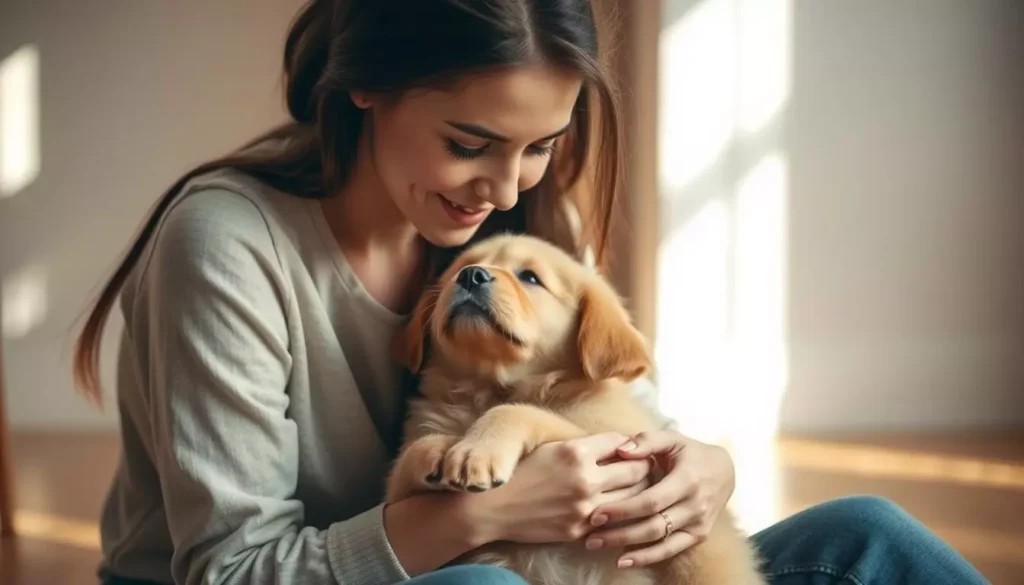
Building Trust and Confidence in Dogs
Building trust in dogs is key to their confidence and behavior. It's important to establish leadership. This creates a clear structure where my dog knows what's expected.
Clear and consistent commands help my dog understand their role. This boosts their security. Watching how my dog reacts helps me fine-tune my approach. It builds a trusting and guiding atmosphere.
Establishing a Leader-Follower Relationship
Creating a leader-follower relationship is crucial in dog training and trust. It greatly impacts my dog's confidence. As their leader, I must be attentive to their needs, especially when they're unsure.
By offering support and reassurance, I help my dog tackle challenges better. This is vital for their growth.
To build this relationship, I use positive reinforcement and consistent commands. Regular training sessions strengthen our bond. I also guide my dog through new experiences, offering support.
These strategies not only build trust but also boost my dog's confidence. The leader-follower relationship is essential for a balanced, trusting partnership between us.
Creating Positive Experiences
It's key to make sure my dog has positive experiences to boost their confidence. Every time we interact, I use positive reinforcement. This helps build a strong foundation for my dog's confidence.
When I reward good behavior, my dog learns to do the right thing. They start to see scary situations in a new light. This is a big step towards becoming a more confident dog.
Adding more playtime to our days helps my dog feel better about themselves. I introduce new toys and games to keep them curious. This shows them that exploring can be fun.
Meeting other dogs or friendly people also helps. It teaches them that new experiences can be enjoyable and lead to connections.
By always focusing on the positive, I help my dog's emotional health. This approach lets them thrive and enjoy every moment. It changes their view of life, making them more confident and joyful.
Desensitization and Counter-Conditioning Techniques
To help my dog feel more confident, I use desensitization and counter-conditioning. These methods help my dog face fears in a supportive way. It's important to take it slow and make sure my dog has positive experiences.
First, I identify what my dog fears. It could be loud noises, car rides, or strangers. Knowing what triggers their fear helps me manage how much they are exposed to. I reward them with treats and praise to help them associate these situations with good things.
Watching my dog's reactions is key. If they seem stressed, I slow down the exposure. With patience and consistency, my dog becomes less scared and more confident in different places.
| Desensitization Techniques | Counter-Conditioning Tips |
|---|---|
| Gradual exposure to triggers | Use high-value treats as rewards |
| Shorter, controlled sessions | Pair exposure with enjoyable activities |
| Decrease proximity to triggers over time | Establish a calm environment during training |
| Monitor stress signals | Always end sessions on a positive note |
Using these techniques regularly helps my dog become more confident and resilient. Spending time on desensitization and counter-conditioning strengthens our bond.
Gradually Exposing Your Dog to New Environments
Helping dogs get used to new places is very important. I start with quiet, less busy spots where they feel safe. This lets me see how they're doing and know when to slow down.
It's vital to have a safe area for them to explore. Letting them go at their own speed helps avoid anxiety. As we move to busier places, they get stronger and more open to new things.
Handling Situations Where Your Dog Feels Anxious
Spotting what makes your dog anxious is crucial. Every dog reacts differently to new places. Using treats or praise when they stay calm helps a lot.
Being patient is essential. I give them breaks when they need them and remind them they're brave. With time and positive actions, their confidence grows, making our life together better.
For Adult Dogs: Confidence Building Strategies
Building confidence in adult dogs is key for their happiness. I've seen how certain strategies can really help. Training them takes time and effort, but it's worth it.
Relationship-based training is a great way to start. It helps build trust between me and my dog. Doing fun activities together is also important. This includes going on walks, exploring new places, and learning new tricks.
Being consistent is crucial. I make sure to have a routine that includes training and play. This makes my dog feel both challenged and happy. As my dog grows more confident, our bond gets stronger.
In short, building confidence in adult dogs is about trust and fun activities. This not only boosts their confidence but also makes our lives better together.
Why Won't My Dog Come Inside? Understanding Fear Responses
Many dog owners wonder, "why won't my dog come inside?" This question often comes from their pets' dog fears that make them anxious about going home. Dogs might not want to come in because of past experiences, threats they see at home, or anxiety from new sounds or movements outside.
Figuring out why my dog doesn't want to come in helps me understand their fear responses. To tackle these fears, I need to make my home a safe and welcoming place for my dog. This means slowly introducing them to the indoors, rewarding them for good behavior, and keeping the atmosphere calm to reduce stress.
Knowing my dog's specific fears helps me tailor a plan to help them feel more at ease. With patience and understanding, I can make the indoors a place my dog loves. By supporting them consistently and watching their behavior, I can help them feel less anxious and more joyful when they come inside.
Conclusion
Building confidence in dogs takes time, patience, and care. As a dog owner, understanding my dog's behavior is key. I need to use effective training strategies to boost their self-esteem.
This not only helps my dog feel more confident but also strengthens our bond. It's a journey that makes our relationship better.
I've learned that a supportive environment is vital. Positive experiences, like socialization and trust-building, help a lot. Each step we take helps our dog become more confident.
These tips for dog owners are very helpful. They guide us through the challenges of raising our pets.
Consistent effort is essential for building confidence in dogs. Knowing their needs and using thoughtful strategies helps a lot. It turns my furry friend into a happy and self-assured companion.
So, let's start this journey together. We'll make sure our dogs feel safe, loved, and confident every step of the way.

